Analyzing Global Business Issues and Strategies for JCB Excavators
VerifiedAdded on 2020/01/15
|16
|4933
|422
Report
AI Summary
This report examines the global business operations of J.C. Bamford Excavators Ltd. (JCB), a multinational corporation. It delves into JCB's global market entry strategies, including exporting, joint ventures, licensing, and franchising, highlighting their application in diverse markets like India. The report analyzes JCB's international organizational structure, specifically the matrix structure and its global divisions, discussing the challenges of coordination and internal complexity. Furthermore, it explores JCB's global marketing and human resource management strategies. The report concludes with recommendations for JCB to optimize its global presence, addressing issues such as market entry strategy selection, organizational structure, and human resource management to improve efficiency and overcome operational hurdles in a competitive international market. The report also includes tables of contents and references.
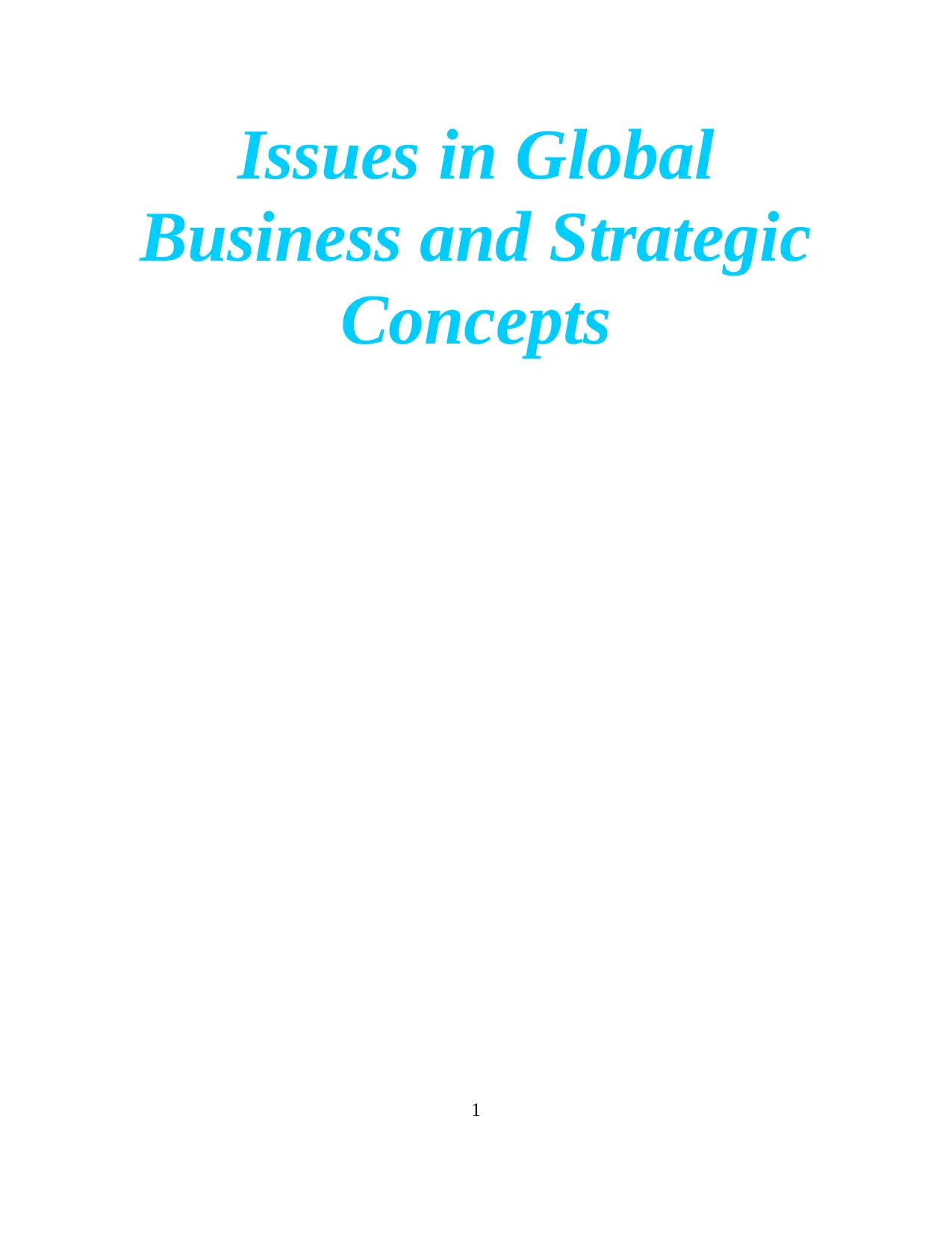
Issues in Global
Business and Strategic
Concepts
1
Business and Strategic
Concepts
1
Paraphrase This Document
Need a fresh take? Get an instant paraphrase of this document with our AI Paraphraser
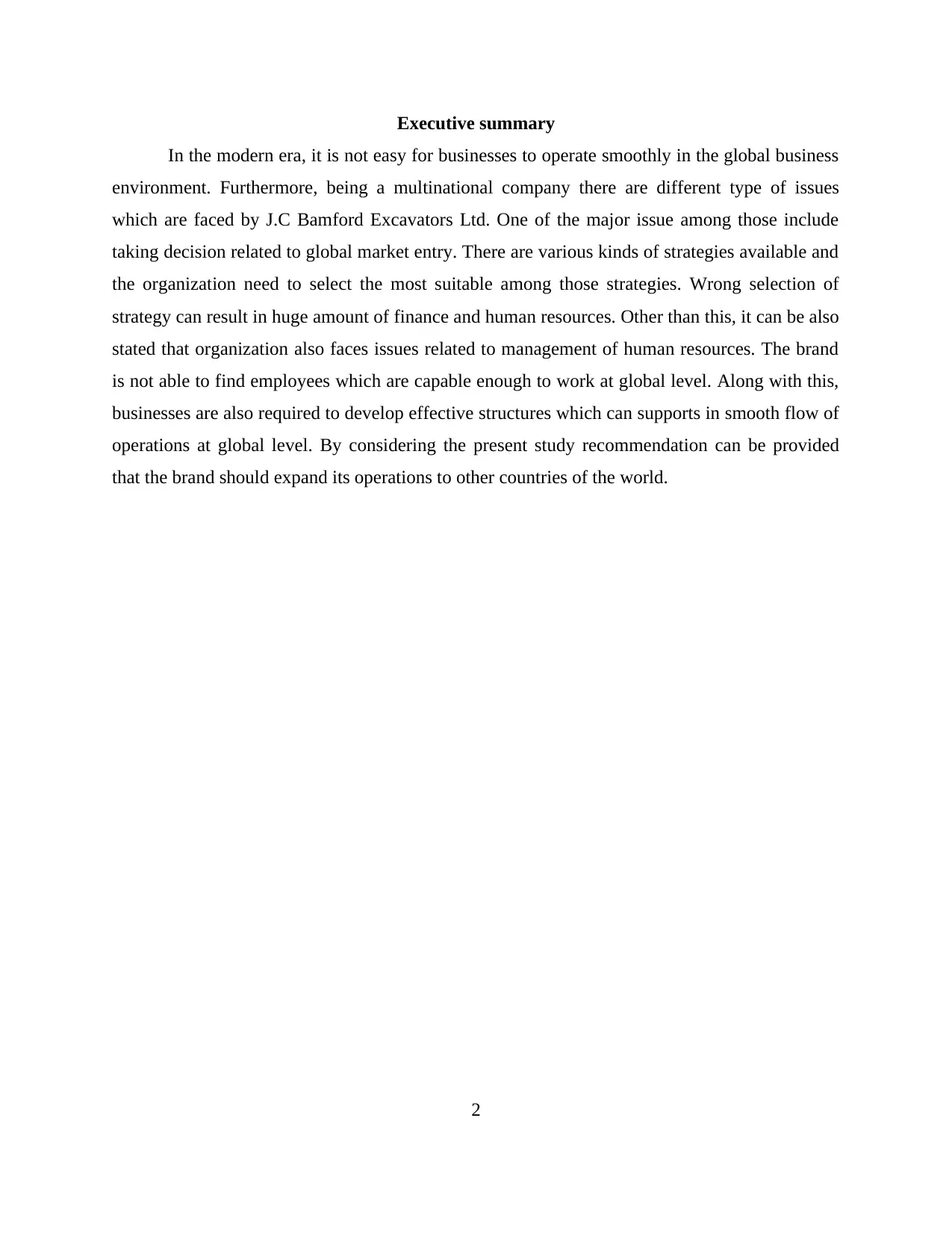
Executive summary
In the modern era, it is not easy for businesses to operate smoothly in the global business
environment. Furthermore, being a multinational company there are different type of issues
which are faced by J.C Bamford Excavators Ltd. One of the major issue among those include
taking decision related to global market entry. There are various kinds of strategies available and
the organization need to select the most suitable among those strategies. Wrong selection of
strategy can result in huge amount of finance and human resources. Other than this, it can be also
stated that organization also faces issues related to management of human resources. The brand
is not able to find employees which are capable enough to work at global level. Along with this,
businesses are also required to develop effective structures which can supports in smooth flow of
operations at global level. By considering the present study recommendation can be provided
that the brand should expand its operations to other countries of the world.
2
In the modern era, it is not easy for businesses to operate smoothly in the global business
environment. Furthermore, being a multinational company there are different type of issues
which are faced by J.C Bamford Excavators Ltd. One of the major issue among those include
taking decision related to global market entry. There are various kinds of strategies available and
the organization need to select the most suitable among those strategies. Wrong selection of
strategy can result in huge amount of finance and human resources. Other than this, it can be also
stated that organization also faces issues related to management of human resources. The brand
is not able to find employees which are capable enough to work at global level. Along with this,
businesses are also required to develop effective structures which can supports in smooth flow of
operations at global level. By considering the present study recommendation can be provided
that the brand should expand its operations to other countries of the world.
2
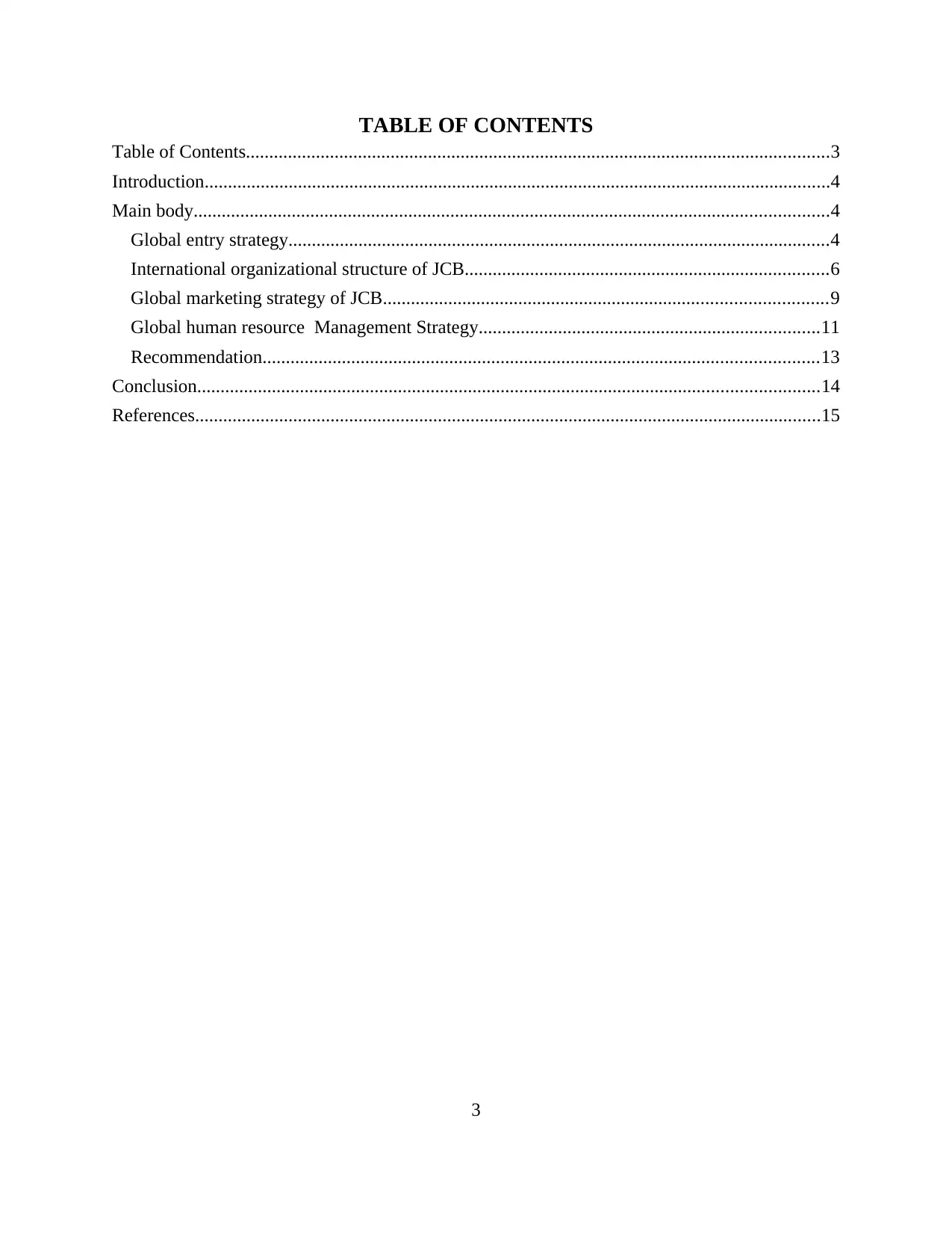
TABLE OF CONTENTS
Table of Contents.............................................................................................................................3
Introduction......................................................................................................................................4
Main body........................................................................................................................................4
Global entry strategy....................................................................................................................4
International organizational structure of JCB..............................................................................6
Global marketing strategy of JCB...............................................................................................9
Global human resource Management Strategy.........................................................................11
Recommendation.......................................................................................................................13
Conclusion.....................................................................................................................................14
References......................................................................................................................................15
3
Table of Contents.............................................................................................................................3
Introduction......................................................................................................................................4
Main body........................................................................................................................................4
Global entry strategy....................................................................................................................4
International organizational structure of JCB..............................................................................6
Global marketing strategy of JCB...............................................................................................9
Global human resource Management Strategy.........................................................................11
Recommendation.......................................................................................................................13
Conclusion.....................................................................................................................................14
References......................................................................................................................................15
3
⊘ This is a preview!⊘
Do you want full access?
Subscribe today to unlock all pages.

Trusted by 1+ million students worldwide
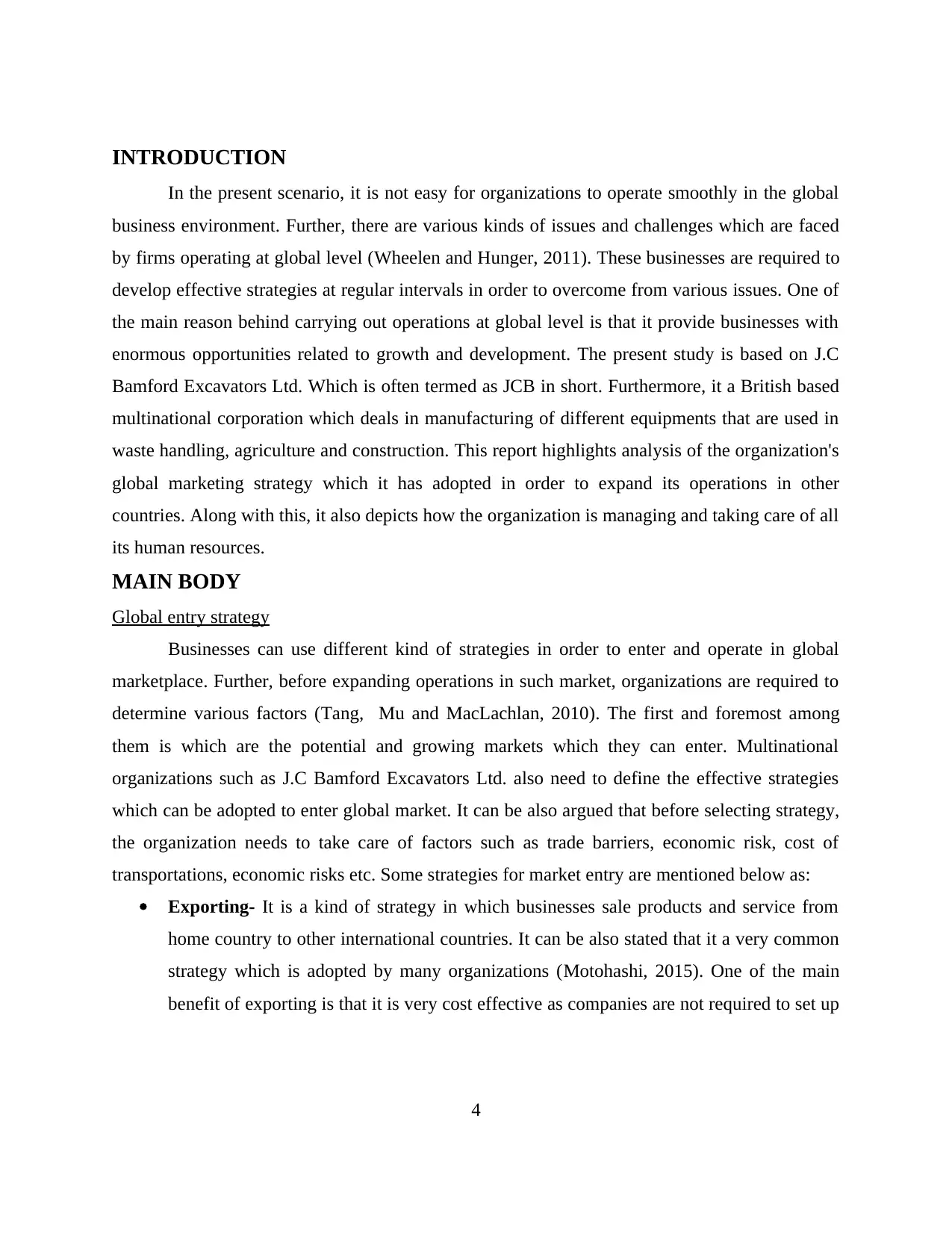
INTRODUCTION
In the present scenario, it is not easy for organizations to operate smoothly in the global
business environment. Further, there are various kinds of issues and challenges which are faced
by firms operating at global level (Wheelen and Hunger, 2011). These businesses are required to
develop effective strategies at regular intervals in order to overcome from various issues. One of
the main reason behind carrying out operations at global level is that it provide businesses with
enormous opportunities related to growth and development. The present study is based on J.C
Bamford Excavators Ltd. Which is often termed as JCB in short. Furthermore, it a British based
multinational corporation which deals in manufacturing of different equipments that are used in
waste handling, agriculture and construction. This report highlights analysis of the organization's
global marketing strategy which it has adopted in order to expand its operations in other
countries. Along with this, it also depicts how the organization is managing and taking care of all
its human resources.
MAIN BODY
Global entry strategy
Businesses can use different kind of strategies in order to enter and operate in global
marketplace. Further, before expanding operations in such market, organizations are required to
determine various factors (Tang, Mu and MacLachlan, 2010). The first and foremost among
them is which are the potential and growing markets which they can enter. Multinational
organizations such as J.C Bamford Excavators Ltd. also need to define the effective strategies
which can be adopted to enter global market. It can be also argued that before selecting strategy,
the organization needs to take care of factors such as trade barriers, economic risk, cost of
transportations, economic risks etc. Some strategies for market entry are mentioned below as:
Exporting- It is a kind of strategy in which businesses sale products and service from
home country to other international countries. It can be also stated that it a very common
strategy which is adopted by many organizations (Motohashi, 2015). One of the main
benefit of exporting is that it is very cost effective as companies are not required to set up
4
In the present scenario, it is not easy for organizations to operate smoothly in the global
business environment. Further, there are various kinds of issues and challenges which are faced
by firms operating at global level (Wheelen and Hunger, 2011). These businesses are required to
develop effective strategies at regular intervals in order to overcome from various issues. One of
the main reason behind carrying out operations at global level is that it provide businesses with
enormous opportunities related to growth and development. The present study is based on J.C
Bamford Excavators Ltd. Which is often termed as JCB in short. Furthermore, it a British based
multinational corporation which deals in manufacturing of different equipments that are used in
waste handling, agriculture and construction. This report highlights analysis of the organization's
global marketing strategy which it has adopted in order to expand its operations in other
countries. Along with this, it also depicts how the organization is managing and taking care of all
its human resources.
MAIN BODY
Global entry strategy
Businesses can use different kind of strategies in order to enter and operate in global
marketplace. Further, before expanding operations in such market, organizations are required to
determine various factors (Tang, Mu and MacLachlan, 2010). The first and foremost among
them is which are the potential and growing markets which they can enter. Multinational
organizations such as J.C Bamford Excavators Ltd. also need to define the effective strategies
which can be adopted to enter global market. It can be also argued that before selecting strategy,
the organization needs to take care of factors such as trade barriers, economic risk, cost of
transportations, economic risks etc. Some strategies for market entry are mentioned below as:
Exporting- It is a kind of strategy in which businesses sale products and service from
home country to other international countries. It can be also stated that it a very common
strategy which is adopted by many organizations (Motohashi, 2015). One of the main
benefit of exporting is that it is very cost effective as companies are not required to set up
4
Paraphrase This Document
Need a fresh take? Get an instant paraphrase of this document with our AI Paraphraser
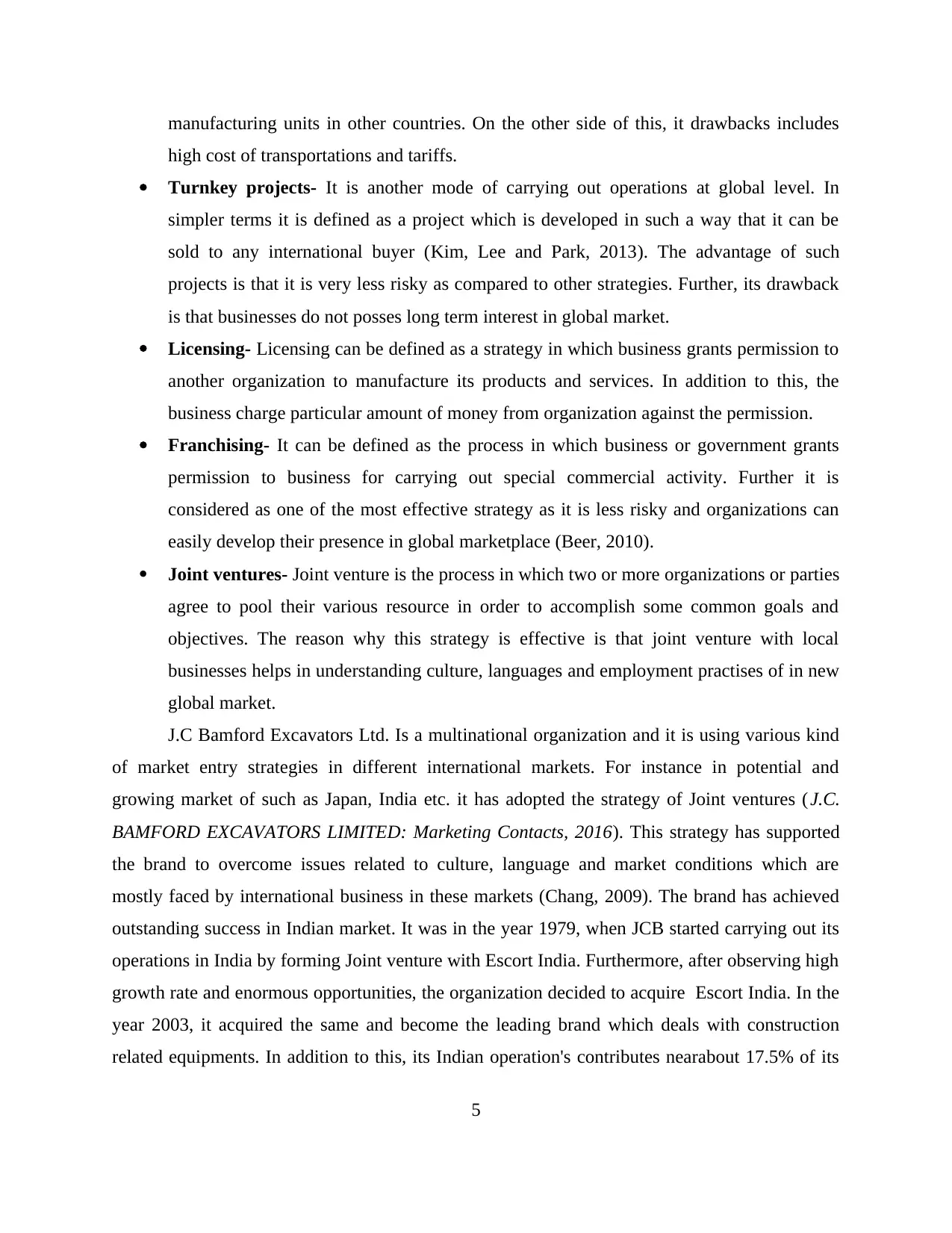
manufacturing units in other countries. On the other side of this, it drawbacks includes
high cost of transportations and tariffs.
Turnkey projects- It is another mode of carrying out operations at global level. In
simpler terms it is defined as a project which is developed in such a way that it can be
sold to any international buyer (Kim, Lee and Park, 2013). The advantage of such
projects is that it is very less risky as compared to other strategies. Further, its drawback
is that businesses do not posses long term interest in global market.
Licensing- Licensing can be defined as a strategy in which business grants permission to
another organization to manufacture its products and services. In addition to this, the
business charge particular amount of money from organization against the permission.
Franchising- It can be defined as the process in which business or government grants
permission to business for carrying out special commercial activity. Further it is
considered as one of the most effective strategy as it is less risky and organizations can
easily develop their presence in global marketplace (Beer, 2010).
Joint ventures- Joint venture is the process in which two or more organizations or parties
agree to pool their various resource in order to accomplish some common goals and
objectives. The reason why this strategy is effective is that joint venture with local
businesses helps in understanding culture, languages and employment practises of in new
global market.
J.C Bamford Excavators Ltd. Is a multinational organization and it is using various kind
of market entry strategies in different international markets. For instance in potential and
growing market of such as Japan, India etc. it has adopted the strategy of Joint ventures (J.C.
BAMFORD EXCAVATORS LIMITED: Marketing Contacts, 2016). This strategy has supported
the brand to overcome issues related to culture, language and market conditions which are
mostly faced by international business in these markets (Chang, 2009). The brand has achieved
outstanding success in Indian market. It was in the year 1979, when JCB started carrying out its
operations in India by forming Joint venture with Escort India. Furthermore, after observing high
growth rate and enormous opportunities, the organization decided to acquire Escort India. In the
year 2003, it acquired the same and become the leading brand which deals with construction
related equipments. In addition to this, its Indian operation's contributes nearabout 17.5% of its
5
high cost of transportations and tariffs.
Turnkey projects- It is another mode of carrying out operations at global level. In
simpler terms it is defined as a project which is developed in such a way that it can be
sold to any international buyer (Kim, Lee and Park, 2013). The advantage of such
projects is that it is very less risky as compared to other strategies. Further, its drawback
is that businesses do not posses long term interest in global market.
Licensing- Licensing can be defined as a strategy in which business grants permission to
another organization to manufacture its products and services. In addition to this, the
business charge particular amount of money from organization against the permission.
Franchising- It can be defined as the process in which business or government grants
permission to business for carrying out special commercial activity. Further it is
considered as one of the most effective strategy as it is less risky and organizations can
easily develop their presence in global marketplace (Beer, 2010).
Joint ventures- Joint venture is the process in which two or more organizations or parties
agree to pool their various resource in order to accomplish some common goals and
objectives. The reason why this strategy is effective is that joint venture with local
businesses helps in understanding culture, languages and employment practises of in new
global market.
J.C Bamford Excavators Ltd. Is a multinational organization and it is using various kind
of market entry strategies in different international markets. For instance in potential and
growing market of such as Japan, India etc. it has adopted the strategy of Joint ventures (J.C.
BAMFORD EXCAVATORS LIMITED: Marketing Contacts, 2016). This strategy has supported
the brand to overcome issues related to culture, language and market conditions which are
mostly faced by international business in these markets (Chang, 2009). The brand has achieved
outstanding success in Indian market. It was in the year 1979, when JCB started carrying out its
operations in India by forming Joint venture with Escort India. Furthermore, after observing high
growth rate and enormous opportunities, the organization decided to acquire Escort India. In the
year 2003, it acquired the same and become the leading brand which deals with construction
related equipments. In addition to this, its Indian operation's contributes nearabout 17.5% of its
5
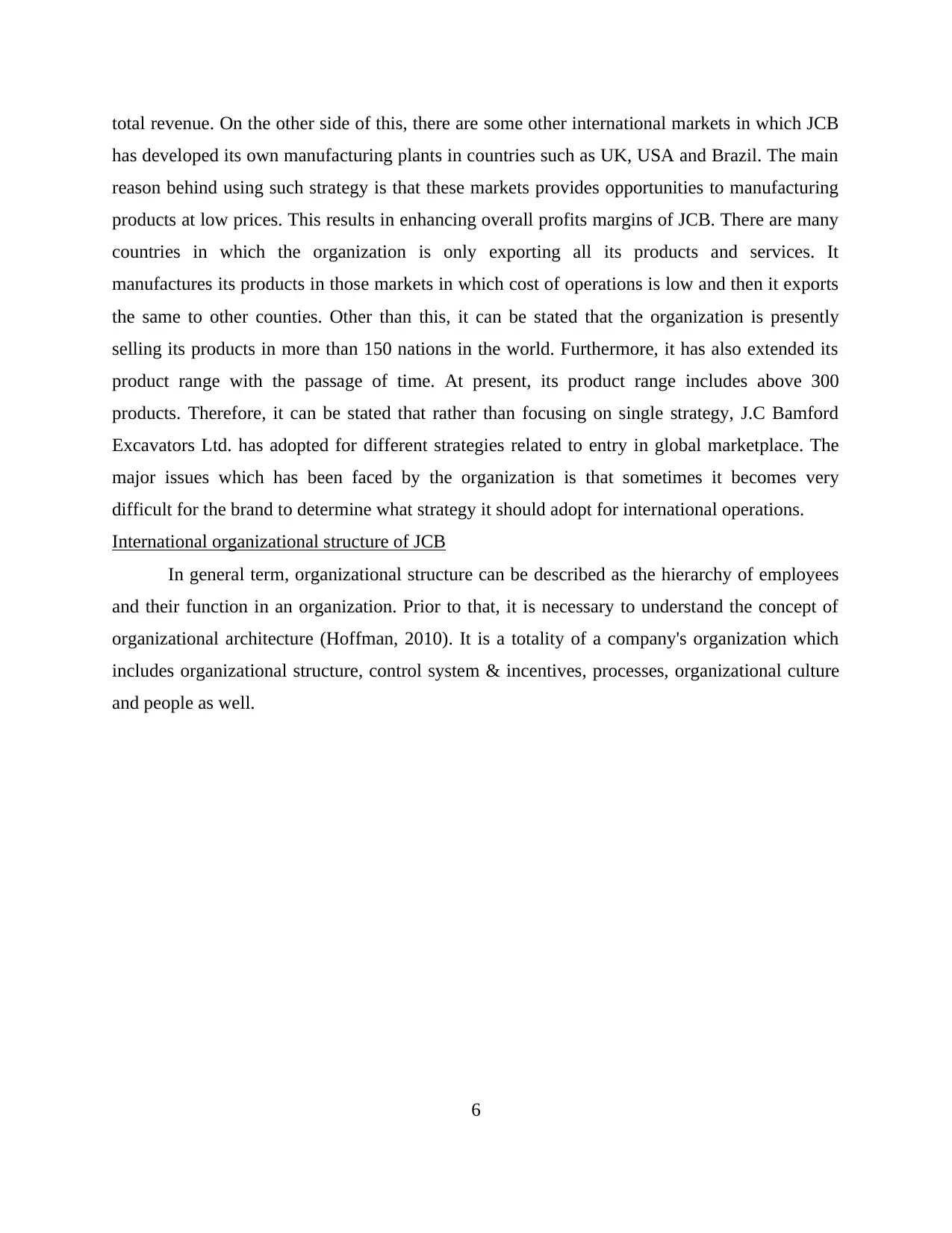
total revenue. On the other side of this, there are some other international markets in which JCB
has developed its own manufacturing plants in countries such as UK, USA and Brazil. The main
reason behind using such strategy is that these markets provides opportunities to manufacturing
products at low prices. This results in enhancing overall profits margins of JCB. There are many
countries in which the organization is only exporting all its products and services. It
manufactures its products in those markets in which cost of operations is low and then it exports
the same to other counties. Other than this, it can be stated that the organization is presently
selling its products in more than 150 nations in the world. Furthermore, it has also extended its
product range with the passage of time. At present, its product range includes above 300
products. Therefore, it can be stated that rather than focusing on single strategy, J.C Bamford
Excavators Ltd. has adopted for different strategies related to entry in global marketplace. The
major issues which has been faced by the organization is that sometimes it becomes very
difficult for the brand to determine what strategy it should adopt for international operations.
International organizational structure of JCB
In general term, organizational structure can be described as the hierarchy of employees
and their function in an organization. Prior to that, it is necessary to understand the concept of
organizational architecture (Hoffman, 2010). It is a totality of a company's organization which
includes organizational structure, control system & incentives, processes, organizational culture
and people as well.
6
has developed its own manufacturing plants in countries such as UK, USA and Brazil. The main
reason behind using such strategy is that these markets provides opportunities to manufacturing
products at low prices. This results in enhancing overall profits margins of JCB. There are many
countries in which the organization is only exporting all its products and services. It
manufactures its products in those markets in which cost of operations is low and then it exports
the same to other counties. Other than this, it can be stated that the organization is presently
selling its products in more than 150 nations in the world. Furthermore, it has also extended its
product range with the passage of time. At present, its product range includes above 300
products. Therefore, it can be stated that rather than focusing on single strategy, J.C Bamford
Excavators Ltd. has adopted for different strategies related to entry in global marketplace. The
major issues which has been faced by the organization is that sometimes it becomes very
difficult for the brand to determine what strategy it should adopt for international operations.
International organizational structure of JCB
In general term, organizational structure can be described as the hierarchy of employees
and their function in an organization. Prior to that, it is necessary to understand the concept of
organizational architecture (Hoffman, 2010). It is a totality of a company's organization which
includes organizational structure, control system & incentives, processes, organizational culture
and people as well.
6
⊘ This is a preview!⊘
Do you want full access?
Subscribe today to unlock all pages.

Trusted by 1+ million students worldwide
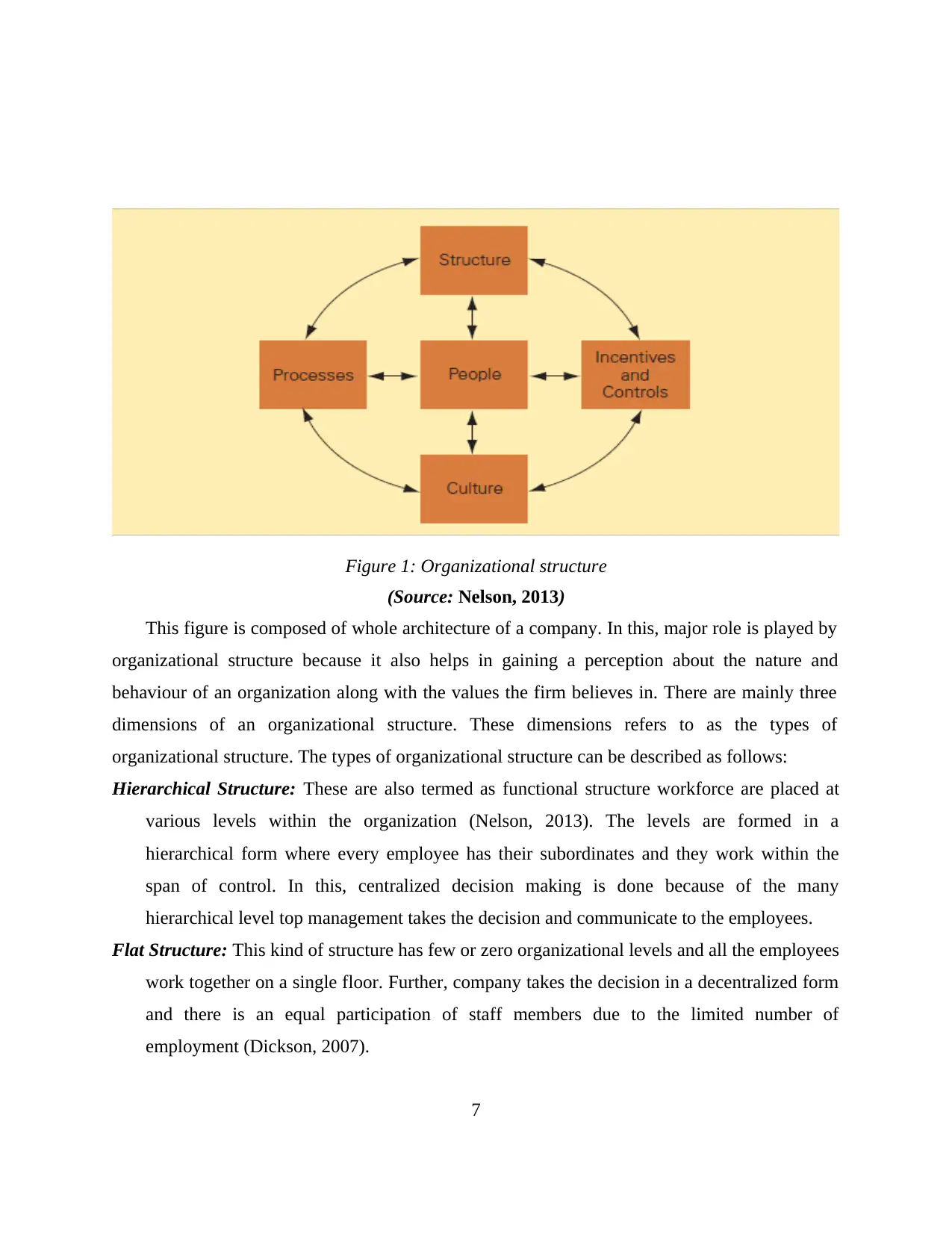
Figure 1: Organizational structure
(Source: Nelson, 2013)
This figure is composed of whole architecture of a company. In this, major role is played by
organizational structure because it also helps in gaining a perception about the nature and
behaviour of an organization along with the values the firm believes in. There are mainly three
dimensions of an organizational structure. These dimensions refers to as the types of
organizational structure. The types of organizational structure can be described as follows:
Hierarchical Structure: These are also termed as functional structure workforce are placed at
various levels within the organization (Nelson, 2013). The levels are formed in a
hierarchical form where every employee has their subordinates and they work within the
span of control. In this, centralized decision making is done because of the many
hierarchical level top management takes the decision and communicate to the employees.
Flat Structure: This kind of structure has few or zero organizational levels and all the employees
work together on a single floor. Further, company takes the decision in a decentralized form
and there is an equal participation of staff members due to the limited number of
employment (Dickson, 2007).
7
(Source: Nelson, 2013)
This figure is composed of whole architecture of a company. In this, major role is played by
organizational structure because it also helps in gaining a perception about the nature and
behaviour of an organization along with the values the firm believes in. There are mainly three
dimensions of an organizational structure. These dimensions refers to as the types of
organizational structure. The types of organizational structure can be described as follows:
Hierarchical Structure: These are also termed as functional structure workforce are placed at
various levels within the organization (Nelson, 2013). The levels are formed in a
hierarchical form where every employee has their subordinates and they work within the
span of control. In this, centralized decision making is done because of the many
hierarchical level top management takes the decision and communicate to the employees.
Flat Structure: This kind of structure has few or zero organizational levels and all the employees
work together on a single floor. Further, company takes the decision in a decentralized form
and there is an equal participation of staff members due to the limited number of
employment (Dickson, 2007).
7
Paraphrase This Document
Need a fresh take? Get an instant paraphrase of this document with our AI Paraphraser
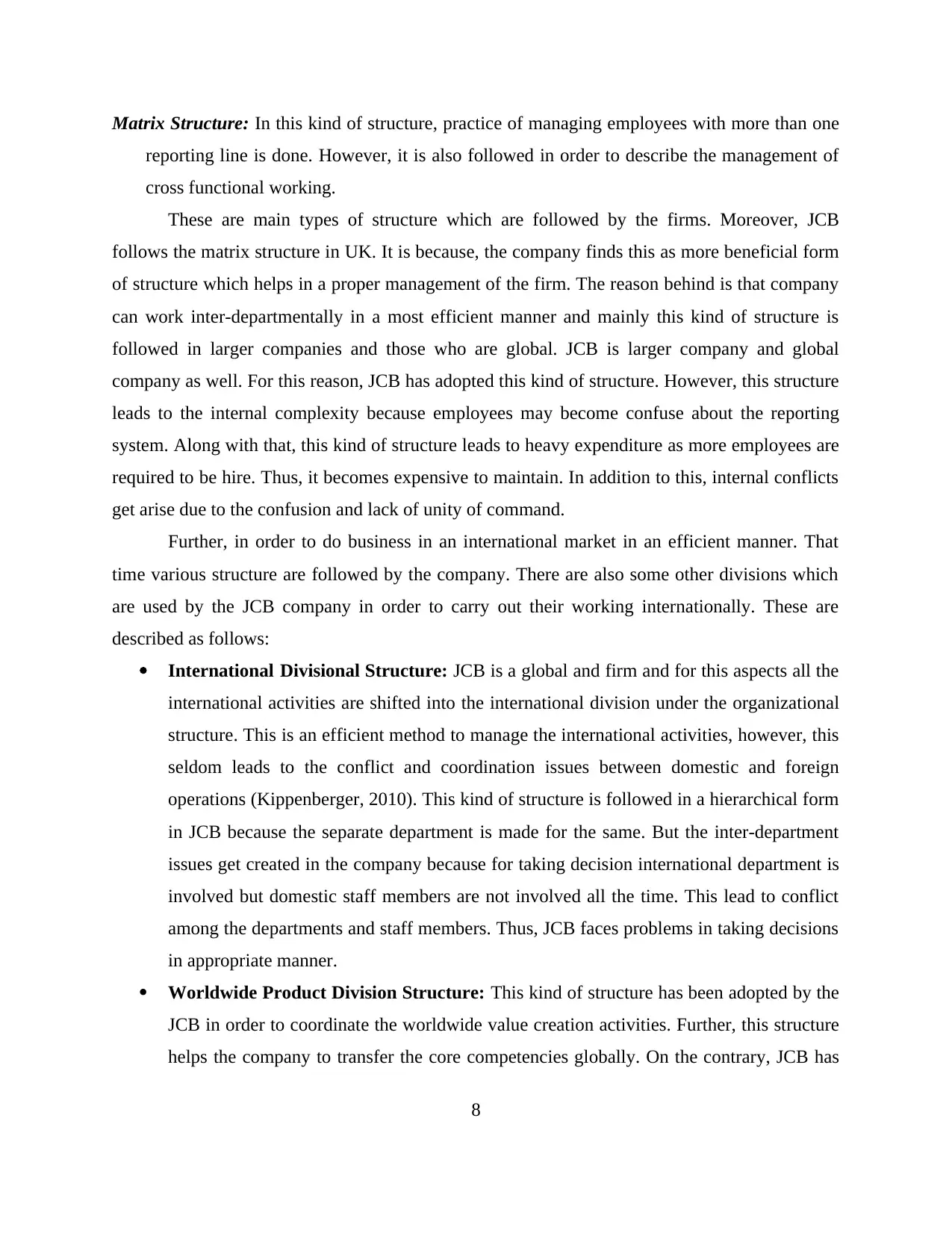
Matrix Structure: In this kind of structure, practice of managing employees with more than one
reporting line is done. However, it is also followed in order to describe the management of
cross functional working.
These are main types of structure which are followed by the firms. Moreover, JCB
follows the matrix structure in UK. It is because, the company finds this as more beneficial form
of structure which helps in a proper management of the firm. The reason behind is that company
can work inter-departmentally in a most efficient manner and mainly this kind of structure is
followed in larger companies and those who are global. JCB is larger company and global
company as well. For this reason, JCB has adopted this kind of structure. However, this structure
leads to the internal complexity because employees may become confuse about the reporting
system. Along with that, this kind of structure leads to heavy expenditure as more employees are
required to be hire. Thus, it becomes expensive to maintain. In addition to this, internal conflicts
get arise due to the confusion and lack of unity of command.
Further, in order to do business in an international market in an efficient manner. That
time various structure are followed by the company. There are also some other divisions which
are used by the JCB company in order to carry out their working internationally. These are
described as follows:
International Divisional Structure: JCB is a global and firm and for this aspects all the
international activities are shifted into the international division under the organizational
structure. This is an efficient method to manage the international activities, however, this
seldom leads to the conflict and coordination issues between domestic and foreign
operations (Kippenberger, 2010). This kind of structure is followed in a hierarchical form
in JCB because the separate department is made for the same. But the inter-department
issues get created in the company because for taking decision international department is
involved but domestic staff members are not involved all the time. This lead to conflict
among the departments and staff members. Thus, JCB faces problems in taking decisions
in appropriate manner.
Worldwide Product Division Structure: This kind of structure has been adopted by the
JCB in order to coordinate the worldwide value creation activities. Further, this structure
helps the company to transfer the core competencies globally. On the contrary, JCB has
8
reporting line is done. However, it is also followed in order to describe the management of
cross functional working.
These are main types of structure which are followed by the firms. Moreover, JCB
follows the matrix structure in UK. It is because, the company finds this as more beneficial form
of structure which helps in a proper management of the firm. The reason behind is that company
can work inter-departmentally in a most efficient manner and mainly this kind of structure is
followed in larger companies and those who are global. JCB is larger company and global
company as well. For this reason, JCB has adopted this kind of structure. However, this structure
leads to the internal complexity because employees may become confuse about the reporting
system. Along with that, this kind of structure leads to heavy expenditure as more employees are
required to be hire. Thus, it becomes expensive to maintain. In addition to this, internal conflicts
get arise due to the confusion and lack of unity of command.
Further, in order to do business in an international market in an efficient manner. That
time various structure are followed by the company. There are also some other divisions which
are used by the JCB company in order to carry out their working internationally. These are
described as follows:
International Divisional Structure: JCB is a global and firm and for this aspects all the
international activities are shifted into the international division under the organizational
structure. This is an efficient method to manage the international activities, however, this
seldom leads to the conflict and coordination issues between domestic and foreign
operations (Kippenberger, 2010). This kind of structure is followed in a hierarchical form
in JCB because the separate department is made for the same. But the inter-department
issues get created in the company because for taking decision international department is
involved but domestic staff members are not involved all the time. This lead to conflict
among the departments and staff members. Thus, JCB faces problems in taking decisions
in appropriate manner.
Worldwide Product Division Structure: This kind of structure has been adopted by the
JCB in order to coordinate the worldwide value creation activities. Further, this structure
helps the company to transfer the core competencies globally. On the contrary, JCB has
8
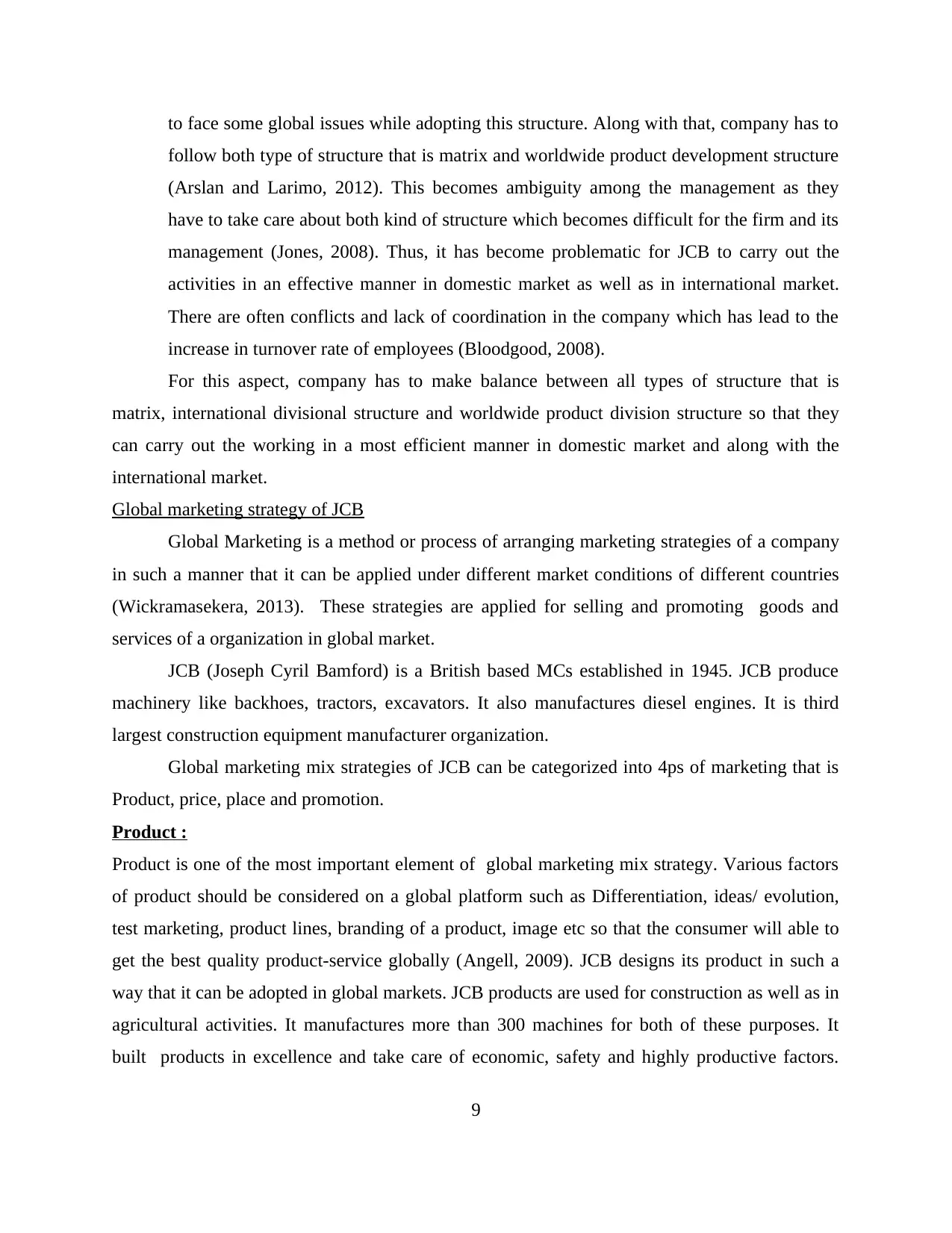
to face some global issues while adopting this structure. Along with that, company has to
follow both type of structure that is matrix and worldwide product development structure
(Arslan and Larimo, 2012). This becomes ambiguity among the management as they
have to take care about both kind of structure which becomes difficult for the firm and its
management (Jones, 2008). Thus, it has become problematic for JCB to carry out the
activities in an effective manner in domestic market as well as in international market.
There are often conflicts and lack of coordination in the company which has lead to the
increase in turnover rate of employees (Bloodgood, 2008).
For this aspect, company has to make balance between all types of structure that is
matrix, international divisional structure and worldwide product division structure so that they
can carry out the working in a most efficient manner in domestic market and along with the
international market.
Global marketing strategy of JCB
Global Marketing is a method or process of arranging marketing strategies of a company
in such a manner that it can be applied under different market conditions of different countries
(Wickramasekera, 2013). These strategies are applied for selling and promoting goods and
services of a organization in global market.
JCB (Joseph Cyril Bamford) is a British based MCs established in 1945. JCB produce
machinery like backhoes, tractors, excavators. It also manufactures diesel engines. It is third
largest construction equipment manufacturer organization.
Global marketing mix strategies of JCB can be categorized into 4ps of marketing that is
Product, price, place and promotion.
Product :
Product is one of the most important element of global marketing mix strategy. Various factors
of product should be considered on a global platform such as Differentiation, ideas/ evolution,
test marketing, product lines, branding of a product, image etc so that the consumer will able to
get the best quality product-service globally (Angell, 2009). JCB designs its product in such a
way that it can be adopted in global markets. JCB products are used for construction as well as in
agricultural activities. It manufactures more than 300 machines for both of these purposes. It
built products in excellence and take care of economic, safety and highly productive factors.
9
follow both type of structure that is matrix and worldwide product development structure
(Arslan and Larimo, 2012). This becomes ambiguity among the management as they
have to take care about both kind of structure which becomes difficult for the firm and its
management (Jones, 2008). Thus, it has become problematic for JCB to carry out the
activities in an effective manner in domestic market as well as in international market.
There are often conflicts and lack of coordination in the company which has lead to the
increase in turnover rate of employees (Bloodgood, 2008).
For this aspect, company has to make balance between all types of structure that is
matrix, international divisional structure and worldwide product division structure so that they
can carry out the working in a most efficient manner in domestic market and along with the
international market.
Global marketing strategy of JCB
Global Marketing is a method or process of arranging marketing strategies of a company
in such a manner that it can be applied under different market conditions of different countries
(Wickramasekera, 2013). These strategies are applied for selling and promoting goods and
services of a organization in global market.
JCB (Joseph Cyril Bamford) is a British based MCs established in 1945. JCB produce
machinery like backhoes, tractors, excavators. It also manufactures diesel engines. It is third
largest construction equipment manufacturer organization.
Global marketing mix strategies of JCB can be categorized into 4ps of marketing that is
Product, price, place and promotion.
Product :
Product is one of the most important element of global marketing mix strategy. Various factors
of product should be considered on a global platform such as Differentiation, ideas/ evolution,
test marketing, product lines, branding of a product, image etc so that the consumer will able to
get the best quality product-service globally (Angell, 2009). JCB designs its product in such a
way that it can be adopted in global markets. JCB products are used for construction as well as in
agricultural activities. It manufactures more than 300 machines for both of these purposes. It
built products in excellence and take care of economic, safety and highly productive factors.
9
⊘ This is a preview!⊘
Do you want full access?
Subscribe today to unlock all pages.

Trusted by 1+ million students worldwide
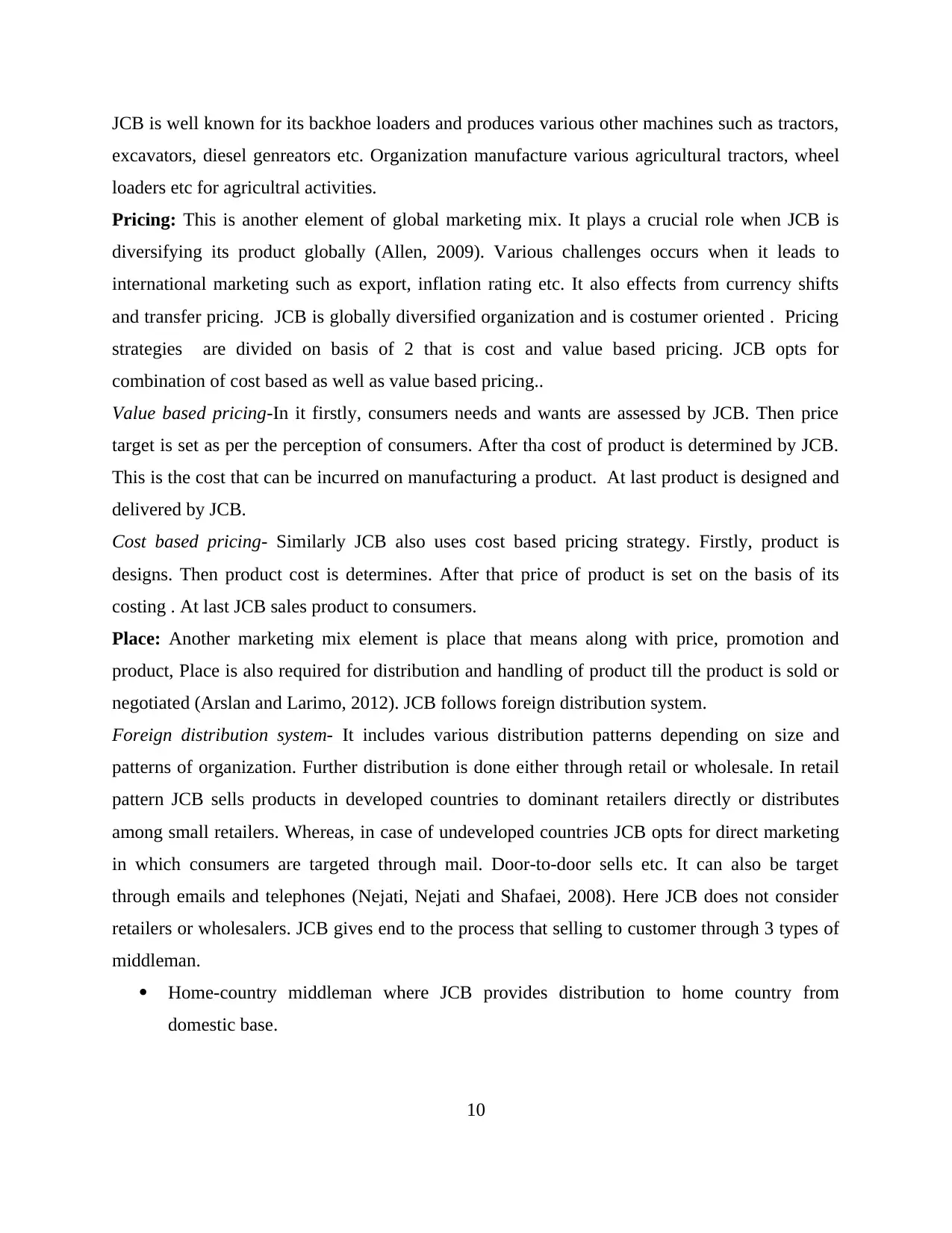
JCB is well known for its backhoe loaders and produces various other machines such as tractors,
excavators, diesel genreators etc. Organization manufacture various agricultural tractors, wheel
loaders etc for agricultral activities.
Pricing: This is another element of global marketing mix. It plays a crucial role when JCB is
diversifying its product globally (Allen, 2009). Various challenges occurs when it leads to
international marketing such as export, inflation rating etc. It also effects from currency shifts
and transfer pricing. JCB is globally diversified organization and is costumer oriented . Pricing
strategies are divided on basis of 2 that is cost and value based pricing. JCB opts for
combination of cost based as well as value based pricing..
Value based pricing-In it firstly, consumers needs and wants are assessed by JCB. Then price
target is set as per the perception of consumers. After tha cost of product is determined by JCB.
This is the cost that can be incurred on manufacturing a product. At last product is designed and
delivered by JCB.
Cost based pricing- Similarly JCB also uses cost based pricing strategy. Firstly, product is
designs. Then product cost is determines. After that price of product is set on the basis of its
costing . At last JCB sales product to consumers.
Place: Another marketing mix element is place that means along with price, promotion and
product, Place is also required for distribution and handling of product till the product is sold or
negotiated (Arslan and Larimo, 2012). JCB follows foreign distribution system.
Foreign distribution system- It includes various distribution patterns depending on size and
patterns of organization. Further distribution is done either through retail or wholesale. In retail
pattern JCB sells products in developed countries to dominant retailers directly or distributes
among small retailers. Whereas, in case of undeveloped countries JCB opts for direct marketing
in which consumers are targeted through mail. Door-to-door sells etc. It can also be target
through emails and telephones (Nejati, Nejati and Shafaei, 2008). Here JCB does not consider
retailers or wholesalers. JCB gives end to the process that selling to customer through 3 types of
middleman.
Home-country middleman where JCB provides distribution to home country from
domestic base.
10
excavators, diesel genreators etc. Organization manufacture various agricultural tractors, wheel
loaders etc for agricultral activities.
Pricing: This is another element of global marketing mix. It plays a crucial role when JCB is
diversifying its product globally (Allen, 2009). Various challenges occurs when it leads to
international marketing such as export, inflation rating etc. It also effects from currency shifts
and transfer pricing. JCB is globally diversified organization and is costumer oriented . Pricing
strategies are divided on basis of 2 that is cost and value based pricing. JCB opts for
combination of cost based as well as value based pricing..
Value based pricing-In it firstly, consumers needs and wants are assessed by JCB. Then price
target is set as per the perception of consumers. After tha cost of product is determined by JCB.
This is the cost that can be incurred on manufacturing a product. At last product is designed and
delivered by JCB.
Cost based pricing- Similarly JCB also uses cost based pricing strategy. Firstly, product is
designs. Then product cost is determines. After that price of product is set on the basis of its
costing . At last JCB sales product to consumers.
Place: Another marketing mix element is place that means along with price, promotion and
product, Place is also required for distribution and handling of product till the product is sold or
negotiated (Arslan and Larimo, 2012). JCB follows foreign distribution system.
Foreign distribution system- It includes various distribution patterns depending on size and
patterns of organization. Further distribution is done either through retail or wholesale. In retail
pattern JCB sells products in developed countries to dominant retailers directly or distributes
among small retailers. Whereas, in case of undeveloped countries JCB opts for direct marketing
in which consumers are targeted through mail. Door-to-door sells etc. It can also be target
through emails and telephones (Nejati, Nejati and Shafaei, 2008). Here JCB does not consider
retailers or wholesalers. JCB gives end to the process that selling to customer through 3 types of
middleman.
Home-country middleman where JCB provides distribution to home country from
domestic base.
10
Paraphrase This Document
Need a fresh take? Get an instant paraphrase of this document with our AI Paraphraser
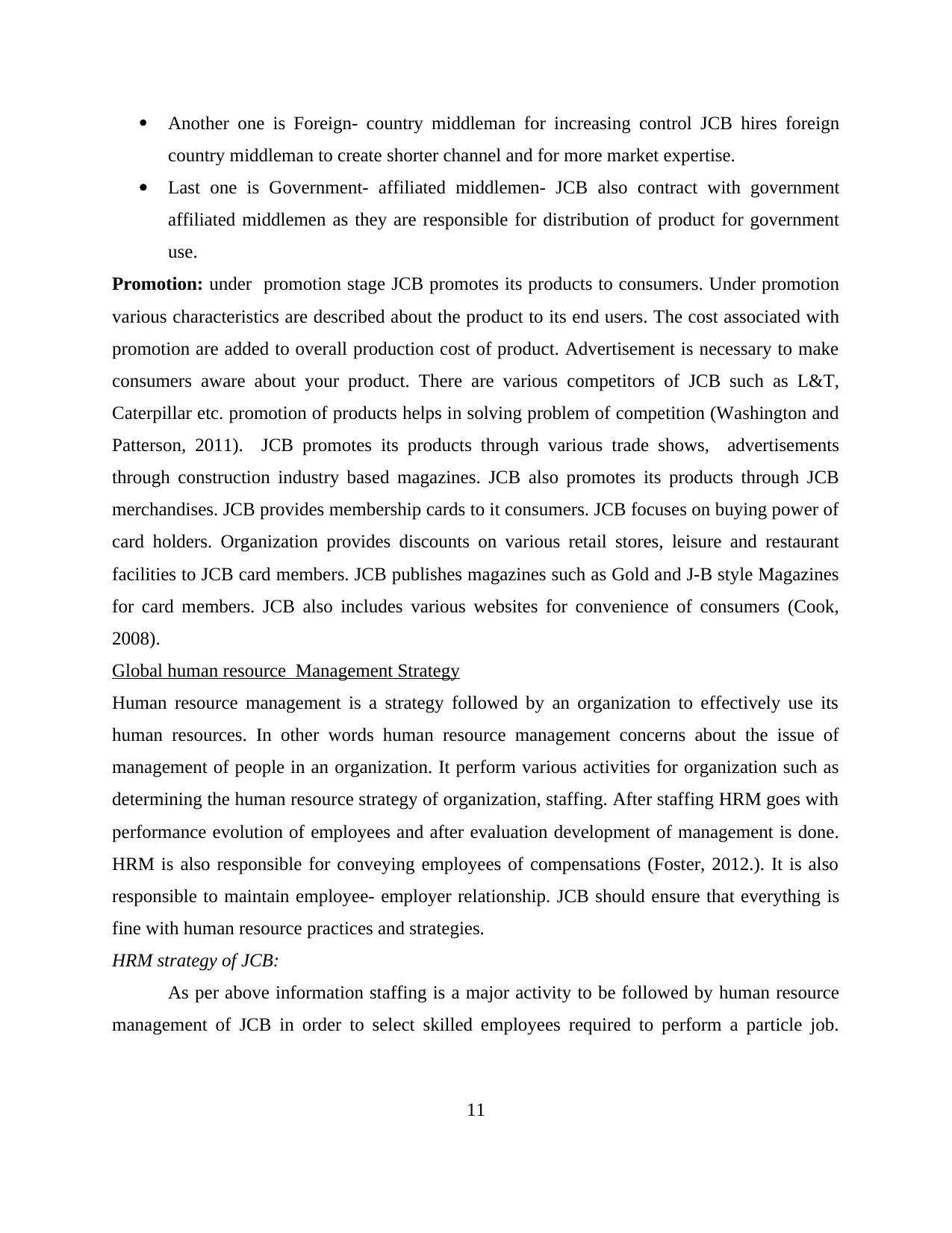
Another one is Foreign- country middleman for increasing control JCB hires foreign
country middleman to create shorter channel and for more market expertise.
Last one is Government- affiliated middlemen- JCB also contract with government
affiliated middlemen as they are responsible for distribution of product for government
use.
Promotion: under promotion stage JCB promotes its products to consumers. Under promotion
various characteristics are described about the product to its end users. The cost associated with
promotion are added to overall production cost of product. Advertisement is necessary to make
consumers aware about your product. There are various competitors of JCB such as L&T,
Caterpillar etc. promotion of products helps in solving problem of competition (Washington and
Patterson, 2011). JCB promotes its products through various trade shows, advertisements
through construction industry based magazines. JCB also promotes its products through JCB
merchandises. JCB provides membership cards to it consumers. JCB focuses on buying power of
card holders. Organization provides discounts on various retail stores, leisure and restaurant
facilities to JCB card members. JCB publishes magazines such as Gold and J-B style Magazines
for card members. JCB also includes various websites for convenience of consumers (Cook,
2008).
Global human resource Management Strategy
Human resource management is a strategy followed by an organization to effectively use its
human resources. In other words human resource management concerns about the issue of
management of people in an organization. It perform various activities for organization such as
determining the human resource strategy of organization, staffing. After staffing HRM goes with
performance evolution of employees and after evaluation development of management is done.
HRM is also responsible for conveying employees of compensations (Foster, 2012.). It is also
responsible to maintain employee- employer relationship. JCB should ensure that everything is
fine with human resource practices and strategies.
HRM strategy of JCB:
As per above information staffing is a major activity to be followed by human resource
management of JCB in order to select skilled employees required to perform a particle job.
11
country middleman to create shorter channel and for more market expertise.
Last one is Government- affiliated middlemen- JCB also contract with government
affiliated middlemen as they are responsible for distribution of product for government
use.
Promotion: under promotion stage JCB promotes its products to consumers. Under promotion
various characteristics are described about the product to its end users. The cost associated with
promotion are added to overall production cost of product. Advertisement is necessary to make
consumers aware about your product. There are various competitors of JCB such as L&T,
Caterpillar etc. promotion of products helps in solving problem of competition (Washington and
Patterson, 2011). JCB promotes its products through various trade shows, advertisements
through construction industry based magazines. JCB also promotes its products through JCB
merchandises. JCB provides membership cards to it consumers. JCB focuses on buying power of
card holders. Organization provides discounts on various retail stores, leisure and restaurant
facilities to JCB card members. JCB publishes magazines such as Gold and J-B style Magazines
for card members. JCB also includes various websites for convenience of consumers (Cook,
2008).
Global human resource Management Strategy
Human resource management is a strategy followed by an organization to effectively use its
human resources. In other words human resource management concerns about the issue of
management of people in an organization. It perform various activities for organization such as
determining the human resource strategy of organization, staffing. After staffing HRM goes with
performance evolution of employees and after evaluation development of management is done.
HRM is also responsible for conveying employees of compensations (Foster, 2012.). It is also
responsible to maintain employee- employer relationship. JCB should ensure that everything is
fine with human resource practices and strategies.
HRM strategy of JCB:
As per above information staffing is a major activity to be followed by human resource
management of JCB in order to select skilled employees required to perform a particle job.
11
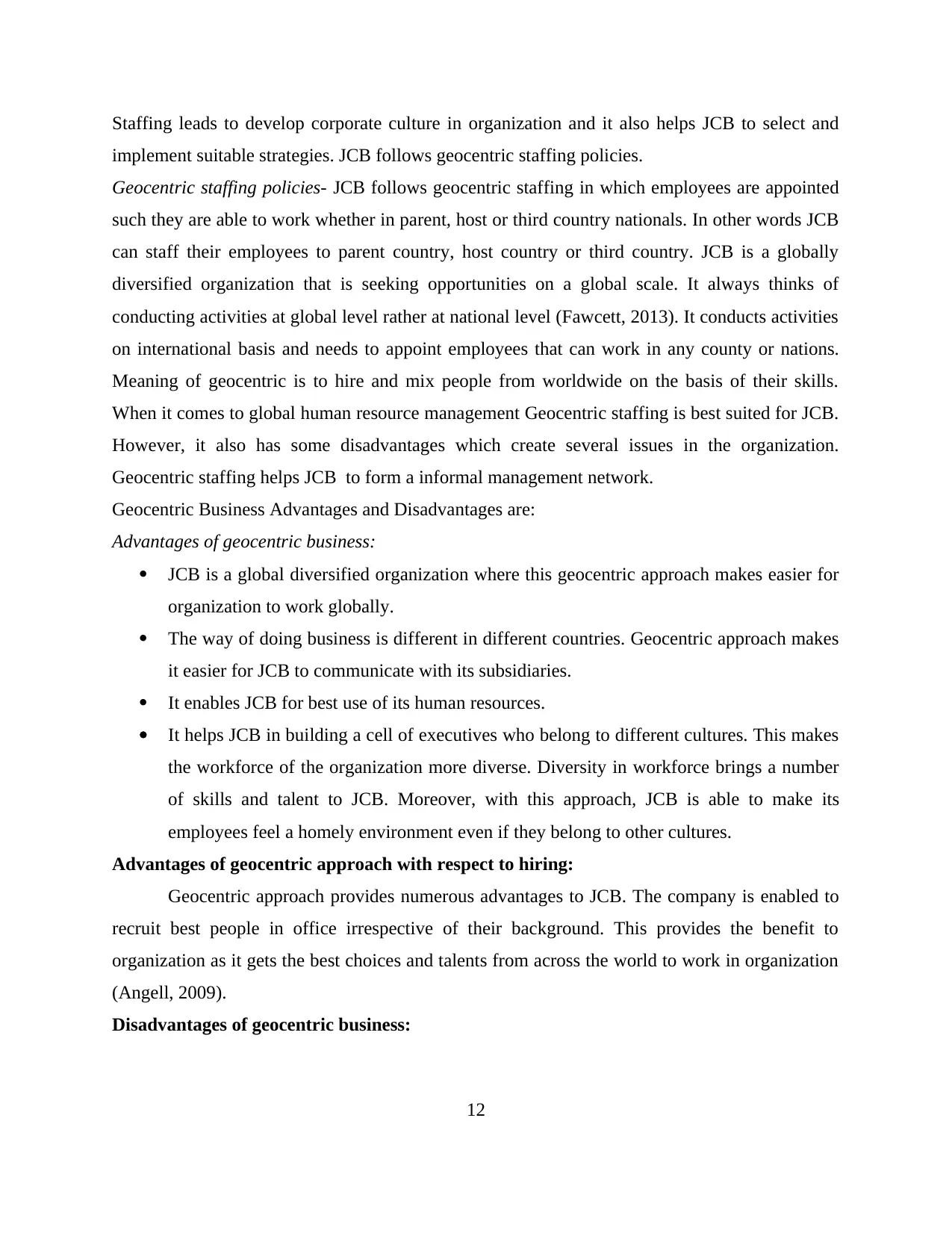
Staffing leads to develop corporate culture in organization and it also helps JCB to select and
implement suitable strategies. JCB follows geocentric staffing policies.
Geocentric staffing policies- JCB follows geocentric staffing in which employees are appointed
such they are able to work whether in parent, host or third country nationals. In other words JCB
can staff their employees to parent country, host country or third country. JCB is a globally
diversified organization that is seeking opportunities on a global scale. It always thinks of
conducting activities at global level rather at national level (Fawcett, 2013). It conducts activities
on international basis and needs to appoint employees that can work in any county or nations.
Meaning of geocentric is to hire and mix people from worldwide on the basis of their skills.
When it comes to global human resource management Geocentric staffing is best suited for JCB.
However, it also has some disadvantages which create several issues in the organization.
Geocentric staffing helps JCB to form a informal management network.
Geocentric Business Advantages and Disadvantages are:
Advantages of geocentric business:
JCB is a global diversified organization where this geocentric approach makes easier for
organization to work globally.
The way of doing business is different in different countries. Geocentric approach makes
it easier for JCB to communicate with its subsidiaries.
It enables JCB for best use of its human resources.
It helps JCB in building a cell of executives who belong to different cultures. This makes
the workforce of the organization more diverse. Diversity in workforce brings a number
of skills and talent to JCB. Moreover, with this approach, JCB is able to make its
employees feel a homely environment even if they belong to other cultures.
Advantages of geocentric approach with respect to hiring:
Geocentric approach provides numerous advantages to JCB. The company is enabled to
recruit best people in office irrespective of their background. This provides the benefit to
organization as it gets the best choices and talents from across the world to work in organization
(Angell, 2009).
Disadvantages of geocentric business:
12
implement suitable strategies. JCB follows geocentric staffing policies.
Geocentric staffing policies- JCB follows geocentric staffing in which employees are appointed
such they are able to work whether in parent, host or third country nationals. In other words JCB
can staff their employees to parent country, host country or third country. JCB is a globally
diversified organization that is seeking opportunities on a global scale. It always thinks of
conducting activities at global level rather at national level (Fawcett, 2013). It conducts activities
on international basis and needs to appoint employees that can work in any county or nations.
Meaning of geocentric is to hire and mix people from worldwide on the basis of their skills.
When it comes to global human resource management Geocentric staffing is best suited for JCB.
However, it also has some disadvantages which create several issues in the organization.
Geocentric staffing helps JCB to form a informal management network.
Geocentric Business Advantages and Disadvantages are:
Advantages of geocentric business:
JCB is a global diversified organization where this geocentric approach makes easier for
organization to work globally.
The way of doing business is different in different countries. Geocentric approach makes
it easier for JCB to communicate with its subsidiaries.
It enables JCB for best use of its human resources.
It helps JCB in building a cell of executives who belong to different cultures. This makes
the workforce of the organization more diverse. Diversity in workforce brings a number
of skills and talent to JCB. Moreover, with this approach, JCB is able to make its
employees feel a homely environment even if they belong to other cultures.
Advantages of geocentric approach with respect to hiring:
Geocentric approach provides numerous advantages to JCB. The company is enabled to
recruit best people in office irrespective of their background. This provides the benefit to
organization as it gets the best choices and talents from across the world to work in organization
(Angell, 2009).
Disadvantages of geocentric business:
12
⊘ This is a preview!⊘
Do you want full access?
Subscribe today to unlock all pages.

Trusted by 1+ million students worldwide
1 out of 16
Related Documents
Your All-in-One AI-Powered Toolkit for Academic Success.
+13062052269
info@desklib.com
Available 24*7 on WhatsApp / Email
![[object Object]](/_next/static/media/star-bottom.7253800d.svg)
Unlock your academic potential
Copyright © 2020–2025 A2Z Services. All Rights Reserved. Developed and managed by ZUCOL.




